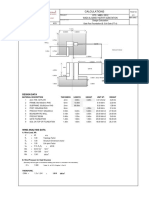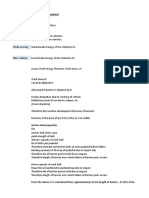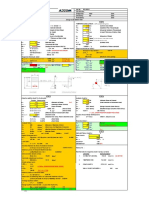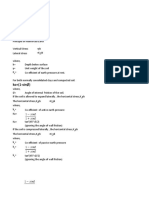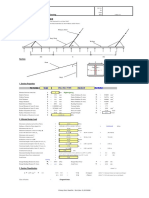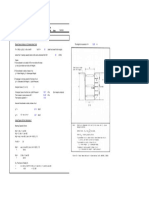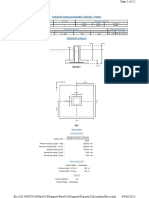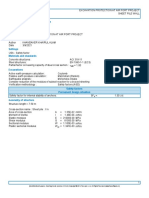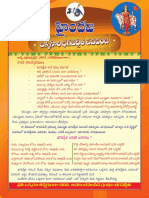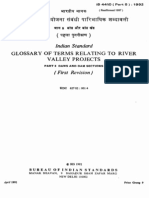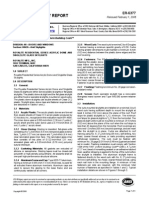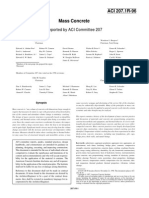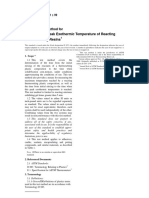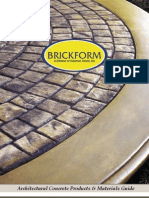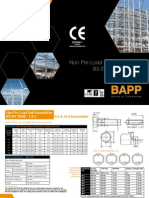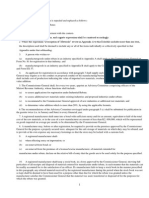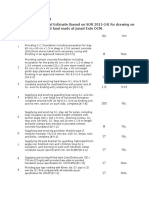Project Client Location
Delhi Metro MC1B
IMCC External slabs and walls
Early Age Thermal Crack Control Reinforcement Design Made by
abc
Date Page Job No
STS
Checked
17-Sep-2013
Revision
Ref 1: Ref 2: INPUT Type of Concrete: Ordinary Portland Cement (OPC) Sulphate Resisting Portland Cement (SRPC) Rapid Hardening Portland Cement (RHPC) Use of Pozzolanic or Latent Hydraulic Materials: Pulverised Fuel Ash (PFA) Ground Granulated Blastfurnace Slags (GGBS) Cement Content (OPC) = PFA Content =
OPC
SRPC RHPC
59120
Early-age thermal crack control in concrete - Ciria Report 91 BS 8007:1987 - Design of concrete structures for retaining aqueous liquids
PFA GGBS
280 120 0 35
kg/m kg/m
Concrete Grade = Dominant Movement = Type of Aggregate:
N/mm2
Quartzite
Type of Formwork:
Steel Formwork 18mm Plywood Formwork
STEEL PLYWOOD
Type of Steel: Diameter of Bars:
415 201
N/mm mm
Section Thickness = Expected Concrete Placing Temperature = Fall in Temperature due to Seasonal Variations (T2) = Maximum Allowable Crack Width (Wmax) = Maximum Thermal Expansion Coefficient (x 10-6/C) = Minimum Thermal Expansion Coefficient (x 10-6/C) = Average Thermal Expansion Coefficient (x 10-6/C) =
1200 25 15 0.2 14.6 11.7 9.2
mm C C mm
USE MAX USE MIN
USE AVERAGE
�Project Client Location
Delhi Metro MC1B
IMCC External slabs and walls
Early Age Thermal Crack Control Reinforcement Design Made by
abc
Date Page Job No
STS
Checked
17-Sep-2013
Revision
CALCULATIONS
Temperature Rise Above Mean Ambient Temperature (C) 35.57 Peak Temperature of Concrete Attributable to the Portland Cement (C) 50.57 Contribution to the Temperature Rise from PFA in Concrete (C) 4.80 Contribution to the Temperature Rise from GGBS in Concrete (C) 0.00 Contribution to the Temperature Rise Increased Placing Temperature (C) 5.34 Design Mix Tempeature (C) 60.71
59120
Maximum Spacing of Cracks (Smax) = (fct/fb) x (/2r) where fct/fb = 0.67 r = As/Ac rcrit = 0.0064 Maximum Crack Width (Wmax) = Smax x (a/2) x (T1 + T2) Rearranging these formulas gives As = (fct/fb) x a x (T1 + T2) x x Ac 4 W max a= T1 + T2 = Ac = Required Area of Steel: Data Checks: r= 0.0098 > rcrit = Smax = Steel to be used: or T16@ 80mm T16@ 82mm = 2513 mm2 = 2440 mm2 As = 12 60.71 250000 2440 0.0064 549 x 10-6 C mm2 mm2 OK mm
�Project Client Location
Delhi Metro MC1B
IMCC External slabs and walls
Early Age Thermal Crack Control Reinforcement Design Made by
abc
Date Page Job No
STS
Checked
17-Sep-2013
Revision
59120
Range of Temperature Rises Above Mean Ambient Temperature (C)
76 74 72 70 68 66 64 62 60 58 56 54 52 50 48 46 44 42 40 38 36 34 32 30 28 26 24 22 20 18 16 14 12 10 8 6 4 2 0 0 200 400 600 800
220 (kg/m) 290 (kg/m) 360 (kg/m) 400 (kg/m)
35.57
500 (kg/m) Design Values
1000
1200
�Project Client Location
Delhi Metro MC1B
IMCC External slabs and walls
Early Age Thermal Crack Control Reinforcement Design Made by
abc
Date Page Job No
STS
Checked
17-Sep-2013
Revision
Ref 1: Ref 2: INPUT Type of Concrete: Ordinary Portland Cement (OPC) Sulphate Resisting Portland Cement (SRPC) Rapid Hardening Portland Cement (RHPC) Use of Pozzolanic or Latent Hydraulic Materials: Pulverised Fuel Ash (PFA) Ground Granulated Blastfurnace Slags (GGBS) Cement Content (OPC) = PFA Content =
OPC SRPC RHPC
59120
Early-age thermal crack control in concrete - Ciria Report 91 BS 8007:1987 - Design of concrete structures for retaining aqueous liquids
PFA GGBS
300 120 0 45
kg/m kg/m
Concrete Grade = Dominant Movement = Type of Aggregate:
N/mm2
Quartzite
Type of Formwork:
Steel Formwork 18mm Plywood Formwork
STEEL PLYWOOD
Type of Steel: Diameter of Bars:
415 201
N/mm mm
Section Thickness = Expected Concrete Placing Temperature = Fall in Temperature due to Seasonal Variations (T2) = Maximum Allowable Crack Width (Wmax) = Maximum Thermal Expansion Coefficient (x 10-6/C) = Minimum Thermal Expansion Coefficient (x 10-6/C) = Average Thermal Expansion Coefficient (x 10-6/C) =
800 25 15 0.2 14.6 11.7 9.2
mm C C mm
USE MAX
USE MIN USE AVERAGE
�Project Client Location
Delhi Metro MC1B
IMCC External slabs and walls
Early Age Thermal Crack Control Reinforcement Design Made by
abc
Date Page Job No
STS
Checked
17-Sep-2013
Revision
CALCULATIONS
Temperature Rise Above Mean Ambient Temperature (C) 34.62 Peak Temperature of Concrete Attributable to the Portland Cement (C) 49.62 Contribution to the Temperature Rise from PFA in Concrete (C) 4.62 Contribution to the Temperature Rise from GGBS in Concrete (C) 0.00 Contribution to the Temperature Rise Increased Placing Temperature (C) 5.19 Design Mix Tempeature (C) 59.43
59120
Maximum Spacing of Cracks (Smax) = (fct/fb) x (/2r) where fct/fb = 0.67 r = As/Ac rcrit = 0.0064 Maximum Crack Width (Wmax) = Smax x (a/2) x (T1 + T2) Rearranging these formulas gives As = (fct/fb) x a x (T1 + T2) x x Ac 4 W max a= T1 + T2 = Ac = Required Area of Steel: Data Checks: r= 0.0096 > rcrit = Smax = Steel to be used: or T16@ 80mm T16@ 84mm = 2513 mm2 = 2389 mm2 As = 12 59.43 250000 2389 0.0064 561 x 10-6 C mm2 mm2 OK mm
�Project Client Location
Delhi Metro MC1B
IMCC External slabs and walls
Early Age Thermal Crack Control Reinforcement Design Made by
abc
Date Page Job No
STS
Checked
17-Sep-2013
Revision
59120
Range of Temperature Rises Above Mean Ambient Temperature (C)
76 74 72 70 68 66 64 62 60 58 56 54 52 50 48 46 44 42 40 38 36 34 32 30 28 26 24 22 20 18 16 14 12 10 8 6 4 2 0 0 200 400 600 Element Thickness
220 (kg/m) 290 (kg/m) 360 (kg/m)
34.62
400 (kg/m) 500 (kg/m) Design Values
800
1000
1200
�Project Client Location
Delhi Metro MC1B
IMCC External slabs and walls
Early Age Thermal Crack Control Reinforcement Design Made by
abc
Date Page Job No
STS
Checked
17-Sep-2013
Revision
Ref 1: Ref 2: INPUT Type of Concrete: Ordinary Portland Cement (OPC) Sulphate Resisting Portland Cement (SRPC) Rapid Hardening Portland Cement (RHPC) Use of Pozzolanic or Latent Hydraulic Materials: Pulverised Fuel Ash (PFA) Ground Granulated Blastfurnace Slags (GGBS) Cement Content (OPC) = PFA Content =
OPC SRPC RHPC
59120
Early-age thermal crack control in concrete - Ciria Report 91 BS 8007:1987 - Design of concrete structures for retaining aqueous liquids
PFA GGBS
320 80 0 35
kg/m kg/m
Concrete Grade = Dominant Movement = Type of Aggregate:
N/mm2
Granite
Type of Formwork:
Steel Formwork 18mm Plywood Formwork
STEEL PLYWOOD
Type of Steel: Diameter of Bars:
500 201
N/mm mm
Section Thickness = Expected Concrete Placing Temperature = Fall in Temperature due to Seasonal Variations (T2) = Maximum Allowable Crack Width (Wmax) = Maximum Thermal Expansion Coefficient (x 10-6/C) = Minimum Thermal Expansion Coefficient (x 10-6/C) = Average Thermal Expansion Coefficient (x 10-6/C) =
1200 25 10 0.2 10.3 8.1 9.2
mm C C mm
USE MAX
USE MIN USE AVERAGE
�Project Client Location
Delhi Metro MC1B
IMCC External slabs and walls
Early Age Thermal Crack Control Reinforcement Design Made by
abc
Date Page Job No
STS
Checked
17-Sep-2013
Revision
CALCULATIONS
Temperature Rise Above Mean Ambient Temperature (C) 40.43 Peak Temperature of Concrete Attributable to the Portland Cement (C) 55.43 Contribution to the Temperature Rise from PFA in Concrete (C) 3.80 Contribution to the Temperature Rise from GGBS in Concrete (C) 0.00 Contribution to the Temperature Rise Increased Placing Temperature (C) 6.06 Design Mix Tempeature (C) 60.29
59120
Maximum Spacing of Cracks (Smax) = (fct/fb) x (/2r) where fct/fb = 0.67 r = As/Ac rcrit = 0.0064 Maximum Crack Width (Wmax) = Smax x (a/2) x (T1 + T2) Rearranging these formulas gives As = (fct/fb) x a x (T1 + T2) x x Ac 4 W max a= T1 + T2 = Ac = Required Area of Steel: Data Checks: r= 0.0074 > rcrit = Smax = Steel to be used: T16@ 100mm = 2011 mm2 As = 9.2 60.29 250000 1858 0.0064 721 x 10-6 C mm2 mm2 OK mm
�Project Client Location
Delhi Metro MC1B
IMCC External slabs and walls
Early Age Thermal Crack Control Reinforcement Design Made by
abc
Date Page Job No
STS
Checked
17-Sep-2013
Revision
59120
Range of Temperature Rises Above Mean Ambient Temperature (C)
76 74 72 70 68 66 64 62 60 58 56 54 52 50 48 46 44 42 40 38 36 34 32 30 28 26 24 22 20 18 16 14 12 10 8 6 4 2 0 0 200 400 600 Element Thickness 800
220 (kg/m)
40.43
290 (kg/m) 360 (kg/m) 400 (kg/m) 500 (kg/m) Design Values
1000
1200




